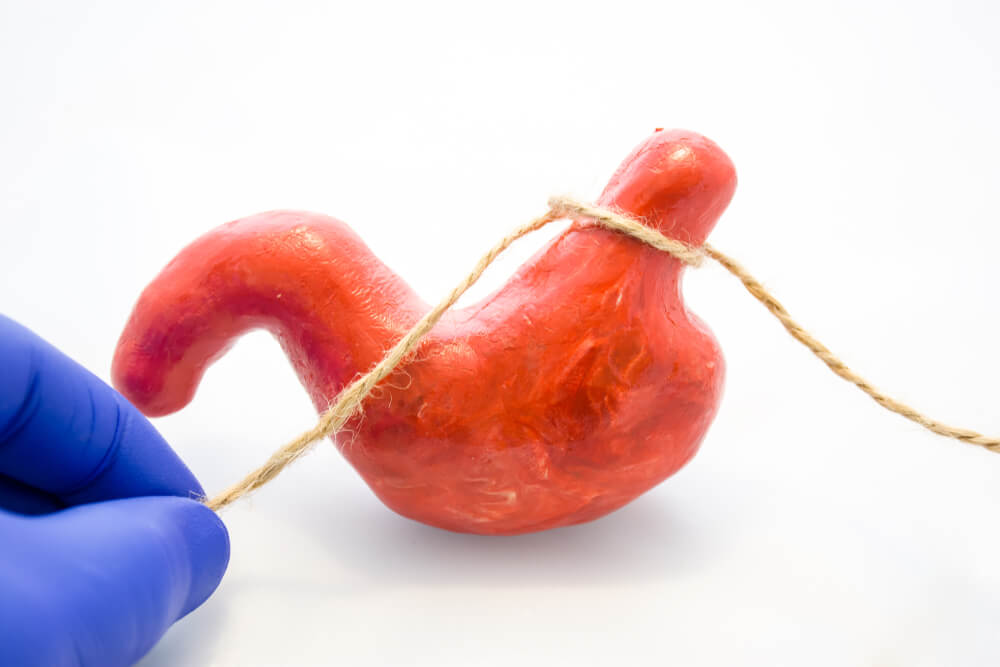Gastric band surgery, or Lap-Band surgery, is a procedure during which an adjustable gastric band is surgically implanted into the stomach’s upper portion to help obese people lose weight. It’s just one of the many types of bariatric surgery that aim to restrict nutrient absorption, and the amount of food patients can eat in one sitting.
After the gastric band procedure, the adjustable band is capable of reducing the size of the stomach without the need to divide it permanently, as other surgeries typically do. Lap-Band is the only “brand name” available for this type of surgery in the country, which got FDA approval back in 2001.
Lap-Band Surgery: How Does it Work?
An adaptable and inflatable tube crafted from soft silicone constitutes the gastric band. Positioned encircling the upper section of the stomach, this inflatable loop forms a ring. Tethered to a port implanted beneath your skin, the surgeon can adjust this inflatable ring. Through the skin port, a saline solution can be injected to achieve an appropriate fit of the band. This action permits a slight gap between the upper and lower parts of the stomach. Consequently, consuming food leads to rapid filling of this upper stomach pouch, inducing a sensation of fullness at a faster rate.
The adjustable gastric band is intended for those obese people who are also dealing with other obesity-related health problems and if other weight loss methods have failed to work with them. Typically, the Lap-Band procedure will be recommended for them by their provider if they are looking for a less invasive and less permanent procedure compared to other available options.

Gastric Band Surgery: How Much Weight Can You Lose?
With the Lap-Band surgery, patients may be able to lose around 40% of their excess weight over a period of 24 months. For instance, if the patients weighed 100 lbs before the procedure, they’d lose around 40 lbs in two years. Still, patients should remember that the results will vary depending on several factors. Also, experts agree that gastric band surgery weight loss will typically be less than in the case of more invasive procedures.
Still, dropping the excess weight can help with the following obesity-related medical conditions:
- Hypertension
- Heart disease
- High cholesterol
- Obstructive sleep apnea
- Type 2 diabetes
- NAFLD, or non-alcoholic fatty liver disease
It’s also worth mentioning that Lap-Band surgery doesn’t have the same hormonal and metabolic effects as other bariatric interventions. It’s usually considered a restrictive procedure, which mostly works by limiting the amount of food the patient can consume.
Adjustable Gastric Band: Candidacy
First off, what are the qualifications? Typically, healthcare providers will recommend Lap-Band surgery in the following cases:
- If the patient has a body mass index of 40 or higher
- If the patient has a BMI of 35 and at least one medical condition caused by obesity
Candidates will also undergo strict medical screening to see whether they are in good shape enough to undergo surgery. These screenings may include blood tests, physicals, and imaging tests. Patients using tobacco and alcohol will be asked to quit before becoming eligible for surgery.
Is Gastric Band Surgery A Major Surgery?
In most cases, patients may opt for having the surgery performed with minimally-invasive methods, such as laparoscopic surgery, instead of making one large incision. On the other hand, recovery time is typically shorter than in the case of other bariatric options.
What Happens During The Procedure?
- First, patients will be under general anesthesia, meaning they’ll be asleep during the operation.
- The laparoscopic procedure will begin with the doctor making a single incision in the abdomen. Through this tiny incision, the surgeon will insert a small pump to inflate the patient’s abdomen with carbon dioxide gas, allowing them to have more room for the operation.
- Then, the surgeon will insert the laparoscope, a tiny medical instrument with a light and a camera at the end, to project the patient’s organs into a screen.
- The surgeon will use several narrow and long tools to reach the stomach via a few more incisions.
- With the help of these instruments, the surgeon will place the gastric bend around the stomach’s top portion, tightening it to form a pouch. After this, the patient’s stomach will somewhat resemble an hourglass, with a very narrow area left between the stomach’s bottom and top portions.
- The band also has a hollow channel that can be filled with fluid, making it adjustable. The surgeon will adjust the pressure of the band by either extracting or adding fluid via a dedicated port.
- The band gets attached to a tiny plastic tube running under the patient’s skin into the port/ Following surgery; providers will be able to access the port with a special needle to either extract or inject the necessary amount of fluid.
- When all of this is done, the expert will release the glass from the abdomen and close the incisions. The procedure shouldn’t take more than 60 minutes.
Diet After The Procedure
Typically, for the first several weeks after the procedure, patients will be on a liquid diet, progressing gradually to pureed and then soft and finally solid foods to promote healing. When the patients are ready to eat solid foods, they must limit their portions to fit the pouch. Also, patients will have to choose quality whole foods to ensure they are getting enough nutrients.
Apart from diet, patients will also have to attend several follow-up appointments during the first year following surgery to make adjustments to the band. As patients lose weight, the band might require tightening to keep the weight down. Patients will also undergo regular blood tests to ensure they are getting just the right amount of nutrients.
Lastly, the Lap-Band is created to last a lifetime, but around 35 to 40% of patients usually remove the band after ten years. Their reasons may be the following:
- Esophageal dilation
- Inadequate weight loss
- Infarction
- Erosion or band slippage
- Severe reflux/heartburn
- Obstruction
On the other hand, other patients may simply opt for another, more permanent bariatric method.

Understand The Risks and Benefits
Typically, the main advantage of the Lap-Band is that it’s minimally invasive and generally has a lower complication risk rate immediately after the operation. Also, it can be safely removed if necessary.
On the downside, the weight loss is less dramatic than in the case of other surgery types, and it may require frequent adjustments in some patients.
All in all, just as with all types of surgery, there are several pros and cons to take into consideration with gastric band surgery.
That said, our experienced professionals are more than ready to help you learn more about the procedure and help you make a more informed decision. Request an appointment now, so we can begin your life-altering journey as soon as possible.


